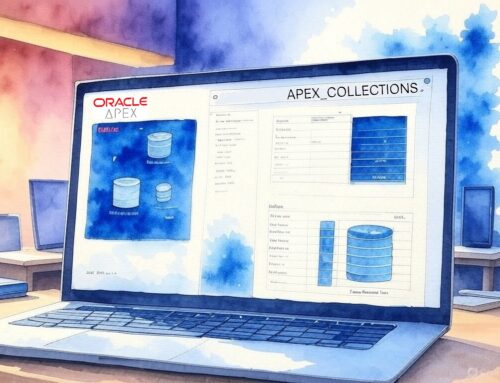Building on our previous discussion about integrating OpenAI Assistants with Oracle APEX, this article focuses on structuring and displaying user interactions efficiently. Instead of frequent database queries, APEX collections provide session-based storage for optimized performance. The PR_LOAD_MESSAGES procedure initializes the conversation by retrieving system messages, structuring collections, and handling errors. Messages are displayed dynamically using an interactive report with AJAX updates for real-time responsiveness. User messages are processed through a RESTful API call to OpenAI, retrieving AI responses and dynamically updating the chat. This architecture ensures efficient message management, real-time interaction, and a scalable AI-powered chat system within Oracle APEX. Now that we’re using a Classic Report with the Cards Container template to display messages, the next step is to configure the actions for the “Send” button. These actions include:
-
SHOW SPINNER – Displays a loading spinner while the message is being processed.
-
PR_ADD_MESSAGE_TO_COLLECTION – Adds the message to the message collection for further processing.
-
PR_PERSONALITY_SELECTION – Selects the appropriate personality or context for the message.
-
PR_SEND_MESSAGE_TO_OPENAI – Sends the message to the OpenAI API for processing.
-
REFRESH CONVERSATION – Updates the conversation view with the new message.
-
HIDE SPINNER – Hides the loading spinner once the message has been processed.

Configuration of dynamic actions in Oracle APEX for integrating OpenAI, showcasing steps like spinner display, message handling, personality selection, and API communication
Let’s look at each action in more detail:
SHOW SPINNER
As seen in the image, the first action will be SHOW SPINNER, an action that will execute JavaScript with the following content:
Is used to display a loading spinner on the screen. This spinner serves as a visual cue to inform the user that a process is underway, such as loading data or performing an operation.
PR_ADD_MESSAGE_TO_COLLECTION
The second action, PR_ADD_MESSAGE_TO_COLLECTION, is more complex:

Oracle APEX interface displaying server-side PL/SQL code used to validate and store user messages in session-based collections
This PL/SQL block is designed to handle user input in an Oracle APEX application. It ensures that a message entered by the user is added to a collection, performs some validation, and handles potential errors gracefully.
This PL/SQL block is used in Oracle APEX to process user input and store it in an APEX collection. It first checks that the input message (:P1_INPUT_MESSAGE) is not empty or null, ensuring valid data. If valid, it adds the message to a specified collection (:P1_COLLECTION_NAME) along with metadata such as the username (:APP_USER), a timestamp, and the session ID for tracking purposes. After successfully adding the message, the input field is cleared to prepare for new entries.
If any errors occur during execution, the block uses APEX’s error-handling framework to log the issue and display a user-friendly error message. This ensures smooth functionality while providing feedback in case of unexpected issues, enhancing both reliability and user experience.
PR_PERSONALITY_SELECTION
This section is the third part of the process, where we personalize the OpenAI assistant’s responses based on the Enneagram personality types. By selecting a specific personality (e.g., Reformer, Helper, Achiever), we tailor the assistant’s tone and style to align with that character’s traits, making interactions more relevant and engaging for the user.

Oracle APEX interface showing PL/SQL code to select personality traits based on Enneagram types for tailored AI responses
Below is the PL/SQL block that handles this logic:
This PL/SQL block generates a personalized response based on the user’s selected Enneagram personality type (:P1_ENNEAGRAM_CHARACTER) in an Oracle APEX application. Using a CASE statement, it checks the selected type (e.g., REFORMER, HELPER, ACHIEVER) and assigns a corresponding message to the page item :P1_PERSONALITY_SELECTION for display. If the selection is unrecognized, a default message is provided.
The block also includes error handling to catch unexpected exceptions. If an error occurs, it logs the issue using APEX’s error framework and displays a user-friendly error message on the application’s error page. This ensures smooth functionality and enhances the user experience by providing tailored responses and robust error management.
PR_SEND_MESSAGE_TO_OPENAI
This is the fourth step, where we send the user’s input and personality selection to the OpenAI API. The PL/SQL block handles the API request, processes the response, and stores the generated message in the application’s collection. If the API call fails, an error message is displayed.

Detailed view of the PL/SQL block in Oracle APEX used to send user input and personality selection to OpenAI API for processing
Below is the PL/SQL block that implements this functionality.
This PL/SQL block begins by retrieving the user’s first name from the GESTALTIA_USERS table, based on the current session’s username. It then prepares the necessary parameters for the OpenAI API request, including the user’s input message (P1_INPUT_MESSAGE), the selected personality (P1_PERSONALITY_SELECTION), and the user’s first name. These parameters are passed to the API using the apex_exec.execute_rest_source method, which performs a POST request to the OpenAI API.
Once the API response is received, the block checks if the status code is 200 (successful). If successful, it extracts the generated message from the response using JSON parsing and stores it in the page item P1_RESPONSE, which will be displayed to the user. Additionally, the message is added to an APEX collection for future use, ensuring that the conversation history is preserved.
In case of an error—whether due to an invalid response or a failed API call—the block assigns an appropriate error message and displays it to the user, including the HTTP status code for transparency. This process ensures smooth interaction with the OpenAI API while providing error handling for unexpected issues.
REFRESH CONVERSATION

The “Refresh Conversation” action ensures that new messages appear instantly in the chat without requiring a manual page reload
The “Refresh Conversation” action updates the Classic Report displaying the conversation. It ensures that new messages, whether from the user or the OpenAI assistant, appear immediately without the need for manual page reloads. This action keeps the conversation up-to-date and ensures a smooth, real-time interaction for the user.
HIDE SPINNER

The “Hide Spinner” action ensures a smooth user experience by removing the loading indicator once the conversation is updated
Finally, the “Hide Spinner” action is used to hide the loading spinner once the conversation has been refreshed and the new message has been processed. This action ensures that the user can seamlessly continue the interaction without the distraction of the loading indicator, providing a smooth and responsive experience.
The code $("#apex_wait_overlay").remove(); and $(".u-Processing").remove(); are used to remove the loading spinner and overlay elements from the page once the process is complete. The first line removes the main wait overlay, and the second removes the processing indicator, making the UI clean and responsive after the action is finished.
For more information, please visit our company website. Stay updated and feel free to reach out for support or contributions!







Leave A Comment